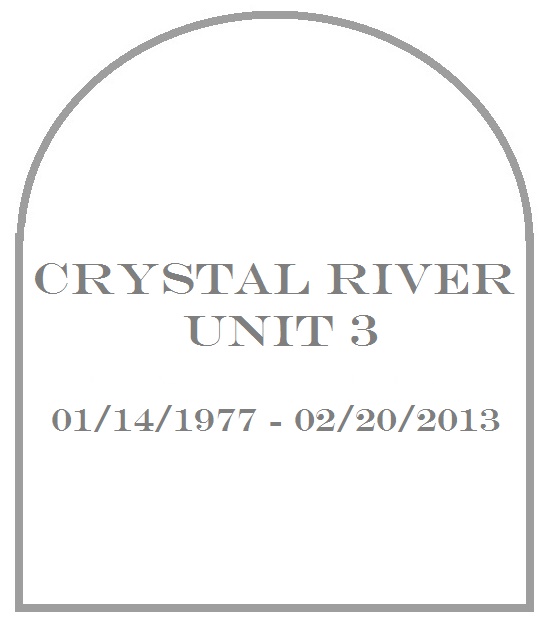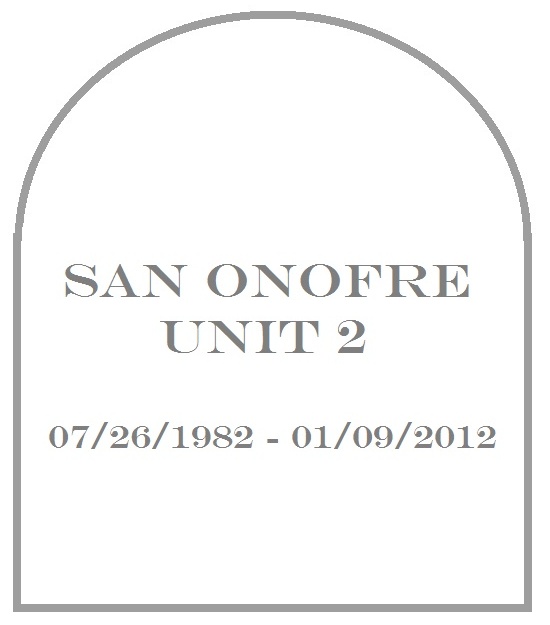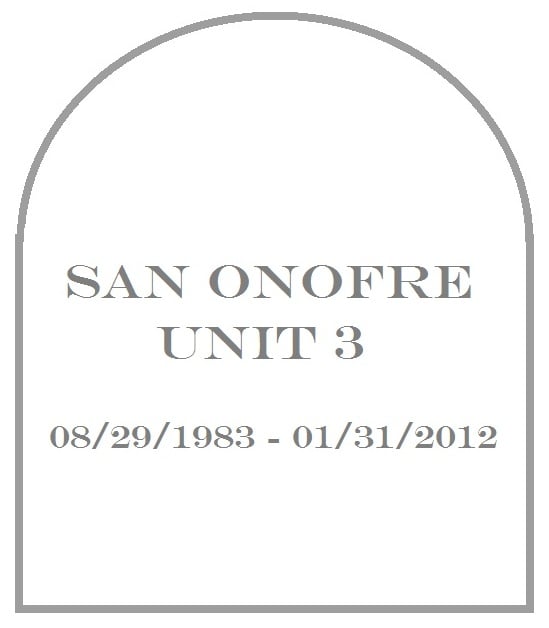There was considerable discussion a decade or so ago about the purported Nuclear Renaissance. New reactors were proposed almost everywhere but Delaware: Florida, Georgia, Alabama, North Carolina, South Carolina, Virginia, Louisiana, Texas, New Jersey, Pennsylvania, and Michigan.
Time turned renaissance into requiem. Owners permanently shut down five reactors since 2013 and have informed the Nuclear Regulatory Commission (NRC) of plans to close several other reactors over the next three years.
Whether you celebrated or mourned the five reactor closures, it’s worth reflecting on what each accomplished during its lifetime.

Crystal River Unit 3 (Florida) first achieved criticality of the reactor core on January 15, 1977. It shut down in September 2009 for a refueling outage during which the steam generators were to be replaced. The containment structure was severely damaged by the hole cut through it to allow replacement of the steam generators. Attempts to repair the damage failed, leading the owner to announce in February 2013 that the reactor would not be restarted.
Crystal River Unit 3 generated 167,517,655 megawatt-hours of electricity during the 27.54 operating years it accumulated. It would have required 556,002,179,473 cubic feet of natural gas, or 58,258,102,181 pounds of coal, or 81,272,814 barrels of oil, or 5,594,496,878 gallons of propane to replace the electricity generated by this reactor during its lifetime.
 Kewaunee (Wisconsin) first achieved criticality of the reactor core on March 7, 1974. It shut down permanently on May 7, 2013, due largely to economic pressure from natural gas generators.
Kewaunee (Wisconsin) first achieved criticality of the reactor core on March 7, 1974. It shut down permanently on May 7, 2013, due largely to economic pressure from natural gas generators.
Kewaunee generated 149,754,450 megawatt-hours of electricity during the 29.75 operating years it accumulated. It would have required 497,044,925,486 cubic feet of natural gas, or 52,080,540,557 pounds of coal, or 81,272,814 barrels of oil, or 5,594,496,878 gallons of propane to replace the electricity generated by this reactor during its lifetime.
 San Onofre Unit 2 (California) first achieved criticality of the reactor core on July 26, 1982. It shut down on January 9, 2012, for a refueling outage. Workers identified abnormally high wear and tear of the tubes in the recently replaced steam generators. Plans to remedy the damage proved futile, leading the owner to announce in June 2013 that the reactor would not be restarted.
San Onofre Unit 2 (California) first achieved criticality of the reactor core on July 26, 1982. It shut down on January 9, 2012, for a refueling outage. Workers identified abnormally high wear and tear of the tubes in the recently replaced steam generators. Plans to remedy the damage proved futile, leading the owner to announce in June 2013 that the reactor would not be restarted.
San Onofre Unit 2 generated 217,796,740 megawatt-hours of electricity during the 27.24 operating years it accumulated. It would have required 772,881,785,952 cubic feet of natural gas, or 75,743,805,520 pounds of coal, or 118,199,853 barrels of oil, or 8,136,407,169 gallons of propane to replace the electricity generated by this reactor during its lifetime.
 San Onofre Unit 3 (California) first achieved criticality of the reactor core on August 29, 1983. It shut down on January 31, 2012, after a tube in one of the replacement steam generators ruptured. Workers identified abnormally high wear and tear of many other tubes in the recently replaced steam generators. Plans to remedy the damage proved futile, leading the owner to announce in June 2013 that the reactor would not be restarted.
San Onofre Unit 3 (California) first achieved criticality of the reactor core on August 29, 1983. It shut down on January 31, 2012, after a tube in one of the replacement steam generators ruptured. Workers identified abnormally high wear and tear of many other tubes in the recently replaced steam generators. Plans to remedy the damage proved futile, leading the owner to announce in June 2013 that the reactor would not be restarted.
San Onofre Unit 3 generated 214,004,380 megawatt-hours of electricity during the 26.5 operating years it accumulated. It would have required 710,294,693,849 cubic feet of natural gas, or 74,424,925,622 pounds of coal, or 116,141,712 barrels of oil, or 7,994,732,958 gallons of propane to replace the electricity generated by this reactor during its lifetime.
 Vermont Yankee (Vermont) first achieved criticality of the reactor core on March 24 1972. It shut down permanently on December 29, 2014, due largely to economic pressure from natural gas generators.
Vermont Yankee (Vermont) first achieved criticality of the reactor core on March 24 1972. It shut down permanently on December 29, 2014, due largely to economic pressure from natural gas generators.
Vermont Yankee generated 163,353,335 megawatt-hours of electricity during the 30.54 operating years it accumulated. It would have required 542,180,693,339 cubic feet of natural gas, or 56,809,864,338 pounds of coal, or 88,653,027 barrels of oil, or 6,102,521,312 gallons of propane to replace the electricity generated by this reactor during its lifetime.
5 Reactors, 0 Meltdowns, 1 Near Miss (nearly)
According to the NRC’s Accident Sequence Precursor program, Kewaunee experienced the most serious safety event among these five reactors. Resin beads leaking from a mixed-bed demineralizer unit in the makeup water system collected in the condensate storage tank. The three auxiliary feedwater pumps transfer water from the condensate storage tank to the steam generators to assist in removing decay heat generated by the reactor core. On November 5, 1975, the motor-driven auxiliary feedwater pumps 1A and 1B failed when resin beds clogged the strainers installed in the piping before the pumps. Turbine-driven auxiliary feedwater pump 1C also failed when resin beads clogged its suction strainer. Fortunately, the feedwater pumps that normally transfer water from the condenser hotwell to the steam generators were unaffected by this problem and remained operable throughout this event.
The NRC calculated a core damage frequency of 2.3E-02 for this incident, solidly among the NRC’s top ten near misses of all time.
(To be fair to Kewaunee’s legacy, the NRC’s estimate was calculated back in the days of the Browns Ferry fire, the Three Mile Island meltdown, and the Chernobyl explosions when risks when risks seemed higher. The Callaway plant (Missouri) also encountered debris in its condensate storage tank that disabled auxiliary feedwater pumps. At the same time, the Callaway plant has a section of plastic tubing in a pipe that disabled one of the emergency service water pumps as well as a component cooling water pump that was broken for three weeks. In November 2004, the NRC estimated the risk from all three of these impairments to be 1.2E-05. Maybe Callaway got the NRC’s volume discount. But the clogged auxiliary feedwater pump failures at Kewaunee in 1982 were more than 150 times riskier to the NRC than the same failures, plus two additional safety component failures, at Callaway in 2004. Which reminds me—why did I begin this sentence with “fair”? Fair and NRC risk assessments are mutually exclusive.)
The Power of Five
These five reactors collectively accumulated 141.6 reactor years of operating time during which they generated 912,426,560 megawatt-hours of electricity.
It would have taken over 3 trillion cubic feet (3,028,404,109,098) of natural gas to generate this much electricity.
It would have taken nearly one-third trillion pounds (317,317,238,218) of coal to generate this much electricity.
It would have taken nearly half a billion barrels (495,180,440) of fuel oil to generate this much electricity.
It would have taken many gallons (34,086,249,484) of propane gas to generate this much electricity.
If you do not like nuclear power, you probably bid “good riddance” to these five reactors.
If you like nuclear power, you probably say “good rides” to these five reactors.
Regardless of your nuclear power stance, if you have an adding machine, calculator or computer spreadsheet, you can continue the ciphering I’ve begun to determine how many mile-long coal trains or supertankers it would have taken to deliver the fuel to the fossil-fired power plants for them to generate as much electricity.
